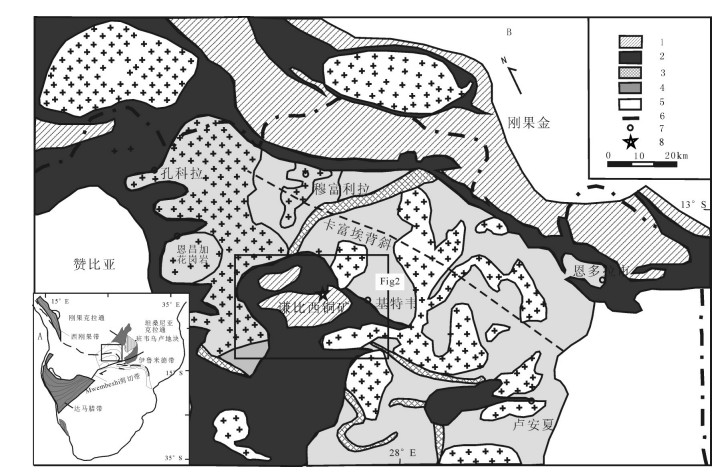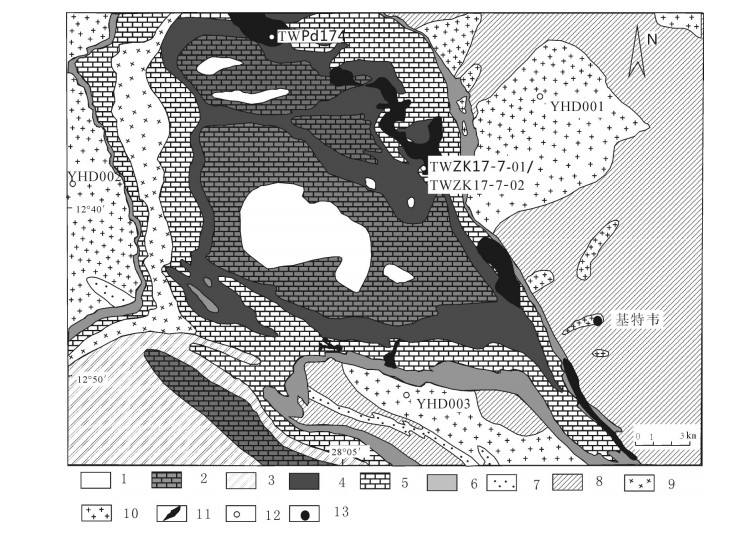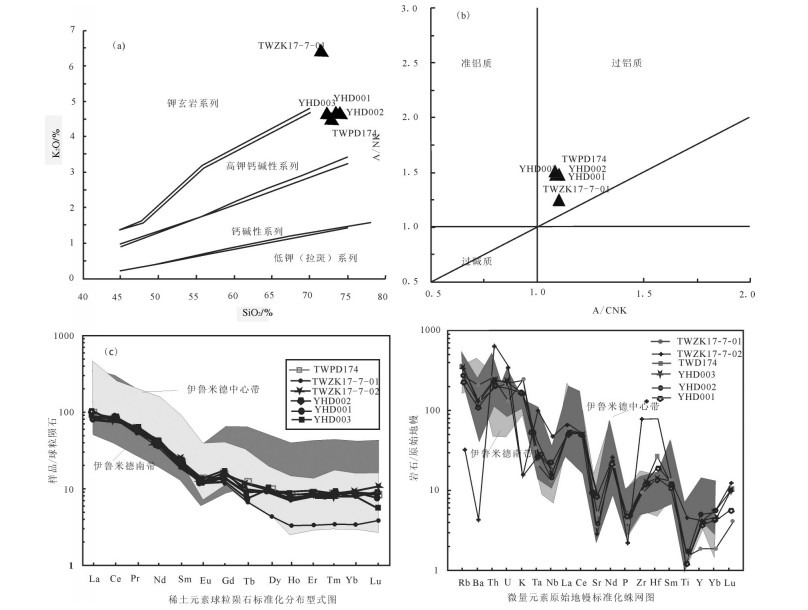-
摘要:
赞比亚谦比西铜矿位于新元古代卢菲利安弧构造带内。矿体呈似层状分布于新元古代罗安组的砂页岩中。罗安组地层不整合于古元古代穆瓦系砂砾岩之上,穆瓦系砂砾岩不整合于下部谦比西花岗岩基底之上。锆石U-Pb测年结果表明谦比西花岗岩年龄为(1984±6)Ma~(1986±6)Ma;穆瓦系年龄上限为(1932±8)Ma。谦比西花岗岩岩石地球化学、稀土元素与球粒陨石配分特征均表现为S型花岗岩的特征。区域地质资料表明,可能由于古元古代班韦卢地块与坦桑尼亚太古宙克拉通碰撞作用诱发了卢菲利安古元古代花岗岩基底的形成;太古宙刚果克拉通于早元古代(2100~1800 Ma)期间活化,并形成一稳定块体。
Abstract:The Chambishi copper mine in Zambia is located in the central Africa copper-cobalt metallogenic belt. The bedded orebodies occur in the Neoproterozoic sandshales of Roan Formation. The Roan Formation unconformably overlies the Early Proterozoic sandy conglomerate of Muwa System, which in turn overlies the lower Chambishi granite basement. U-Pb zircon dating yielded the age of 1984 ±6-1986 ±6 Ma for Chambishi granite, and the upper age limit is 1932 ±8 Ma for Muwa System. The lithogeochemistry and chondrite-normalized REE patterns of Chambishi granites have the characteristics of S-type granites. Combined with the data of regional geological evolution, the authors believe that Archean Congo craton may have experienced activation over a large area during Early Proterozoic period, and a stable ancient block had been formed in the Early Proterozoic period.
-
Keywords:
- Zambia /
- Chambishi copper mine /
- granite /
- zircon U-Pb age
-
1. 引言
铜陵地区位于安徽省境内长江南岸,长江中下游铁铜等多金属成矿带的中部(图 1a)。长江中下游地区有7个矿化集中区(矿集区),从西到东分别是:鄂东、九瑞、安庆—贵池、铜陵、庐枞、宁芜、宁镇矿集区。铜陵矿集区是其中一个重要的矿集区,以盛产铜矿而著名,且已有几千年的开采历史,被誉为中国的古铜都。区内主要产出矽卡岩型、层控矽卡岩型、斑岩型铜矿,同时伴生有金、钼、铅锌等多金属矿床(常印佛等, 1983, 1991, 2017;Wu et al., 2000, 2001;张旗等,2001;王强等,2003;狄永军等,2003;杜杨松等, 2004, 2007;吴才来等,2008;吕庆田等,2009)。这些矿床主要集中分布在铜官山、狮子山、新桥、凤凰山、舒家店、沙滩脚、焦冲矿田内。大量的研究工作表明,这些矿田内的金属矿床与区内中酸性侵入岩关系十分密切(周泰禧等,1987;常印佛等,1991;徐夕生等,2004;杜杨松等, 2004, 2007;吴才来等, 2010, 2013;黄文明等,2019)。区内出露高钾钙碱性和橄榄安粗岩系列侵入岩,其中橄榄安粗岩系列侵入岩时代为145~138 Ma,而高钾钙碱性系列侵入岩年代为152~130 Ma(王彦斌等,2004;Di et al., 2005;张达等,2006;楼亚儿等,2006;吴淦国等,2008;吴才来等, 2008, 2010, 2013)。然而,区内同一系列同一类型的侵入岩具有不同的时代,不同矿田内侵入岩的年龄、系列及成因均有一定的变化,是什么机制导致这种变化?同时,不同矿田侵入岩及矿床的研究程度也存在较大的差异,特别是焦冲矿田侵入岩的研究程度相对较低。焦冲矿田内也存在两个系列侵入岩吗?他们形成的时代与铜陵地区其他岩体的时代一致吗?这些问题仍不清楚。因此,本文试图通过铜陵焦冲矿田侵入岩的锆石U-Pb定年、Hf同位素分析和岩石地球化学研究,对上述问题进行探讨。
2. 地质背景及岩体地质特征
铜陵地区位于扬子地块东北缘的中部,区内沉积了志留纪到三叠纪的海相、滨海相、浅海相及海陆交互相的碎屑岩-碳酸盐岩及硅质岩,以及中三叠世上部月山组到新近纪的陆相碎屑岩夹火山岩(图 1b)。印支运动使中三叠世以前的地层(盖层)发生了一系列褶皱和断裂。褶皱构造自西向东分别为金口岭向斜、铜官山背斜、大通—顺安复向斜(包括青山次级背斜、朱村向斜)、永村桥—舒家店背斜、新屋里复向斜和戴公山背斜(常印佛等,1991;吴才来等,2013;张志辉等,2013)。盖层之下的基底构造分别由东西向、南北向、北北东向3组深大断裂组成,特别是东西向基底构造制约着铜陵地区侵入岩及相关矿产的分布,构成了铜陵地区东西向宽约20 km的构造-岩浆-成矿带(常印佛等,1991)。区内侵入岩可划分为高钾钙碱性系列和橄榄安粗岩系列:前者包括花岗闪长岩、花岗闪长斑岩、石英二长闪长岩、石英二长闪长玢岩,后者包括辉石二长闪长岩、二长岩、石英二长岩等(王强等,2003;吴淦国等,2008;杨小男等,2008;阙朝阳等,2013;吴才来等,2013;Wu et al., 2014, 2017),这些侵入岩均分布在近东西向构造-岩浆-成矿带上(常印佛等,1991;吴才来等,2003;姚孝德等,2012)。研究表明,铜陵高钾钙碱性系列侵入岩中存在大量的暗色微粒闪长质包体和富云母包体,且与铜矿化关系密切;橄榄安粗岩系列侵入岩中存在大量的深源堆积岩包体,且与金矿化关系密切(杨小男等,2007;徐晓春等,2008;吴才来等, 2010, 2013)。
焦冲矿田位于大通—顺安复向斜中的青山次级背斜核部(图 2)。核部最老地层为下三叠统塔山组条带状灰岩(T1t),两边依次为中三叠统南陵湖组薄层灰岩(T2n),及中三叠统分水岭组灰岩夹硅质岩(T2f)。焦冲矿田主要出露辉石二长闪长岩、石英二长闪长岩和花岗闪长岩,岩体呈岩株、岩枝状产出,出露面积很小,约0.1 km2。岩体与围岩接触带发育矽卡岩化、大理岩化及角岩化。区内主要产出层控矽卡岩型金矿,金矿体主要赋存在不同岩性的岩体接触带附近硅质岩中。其中,辉石二长闪长岩位于矿田的中部,呈不规则的北东向,接触带局部地方发育矽卡岩;花岗闪长岩呈北东向岩枝状,分布在辉石二长闪长岩的东南外围;石英二长闪长岩呈不规则岩脉或岩枝状产出,延伸方向以北东向为主,其次为北西向,主要侵位于塔山组地层中,部分呈北西向的岩体侵入到塔山组和南陵湖组灰岩中(图 2)。
3. 定年样品岩石学特征
选择6个岩石样品(10CL506、10CL507、10CL521、17CL505、17CL511、17CL516)开展LAMC-ICP-MS锆石U-Pb定年,主要岩性为辉石二长闪长岩、石英二长闪长岩和花岗闪长岩。各定年样品岩石学特征分述如下:
辉石二长闪长岩(样品10CL507、17CL511):岩石呈灰黑色,具有半自形板柱状粒状结构,块状构造。主要矿物有斜长石、辉石,其次为黑云母和碱性长石,副矿物为锆石、磷灰石。镜下观察,斜长石为自形—半自形长板状,含量60%~70%;辉石为半自形柱粒状,含量15%~20%;黑云母为片状,含量7%~8%;碱性长石为他形粒状,含量8%~12%。锆石呈柱粒状,磷灰石为自形长柱状。岩石局部具有碳酸盐化,部分黑云母被绿泥石交代(图 3a、b)。不透明矿物主要为他形粒状磁黄铁矿,其次为半自形粒状黄铁矿和他形不规则粒状黄铜矿。矿物生成顺序为辉石→斜长石→碱性长石→黑云母→绿泥石→方解石。
石英二长闪长岩(样品10CL506、17CL505、17CL516),呈深灰色,具有半自形粒状不等粒结构和似斑状结构,块状构造。斑晶主要为自形—半自形板柱状斜长石,粒径1~2.5 mm。部分样品的斜长石发生绢云母化和碳酸盐化(如样品10CL506),形成鳞片状绢云母和他形粒状方解石,局部绢云母结晶颗粒粗大,形成少量片状白云母,部分角闪石、黑云母发生绿泥石化。基质主要为他形粒状石英,其次为钾长石(图 3d、e、f)。各主要矿物含量为:斜长石55%~65%,石英10%~15%,钾长石15%,角闪石5%~8%,黑云母5%~7%。不透明矿物主要为半自形粒状磁黄铁矿,其次为自形—半自形粒状黄铁矿、半自形—他形闪锌矿和不规则状黄铜矿。其中,磁黄铁矿先生成,但晚于方解石,黄铁矿后生成,晚于绢云母。根据镜下观察可知透明矿物生成顺序为:角闪石→斜长石→黑云母→石英→钾长石→方解石→绢云母→白云母。
花岗闪长岩(样品10CL521):呈灰白色,具有似斑状不等粒结构,块状构造。斑晶为半自形短柱状斜长石,片状黑云母及半自形—他形角闪石。显微镜下观察,斜长石斑晶大小约为1 mm,具明显的环带结构和聚片双晶。少量斜长石斑晶绢云母化和绿泥石化,局部有黑云母交代角闪石,并残留一部分角闪石,少量斜长石被钾长石交代。薄片中见长英质岩脉的穿插,岩脉主要由半自形粒状石英组成,含少量碱性长石和不透明矿物。基质成分主要为他形粒状碱性长石及少量的他形粒状石英和少量他形不规则状方解石(图 3c)。各主要矿物含量分别为:斜长石50%~65%,石英15%~25%,钾长石10%,角闪石5%~10%,黑云母5%。不透明矿物主要为磁黄铁矿,其次为黄铁矿和黄铜矿。可推测矿物生成顺序为:斜长石→角闪石→黑云母→石英→碱性长石。
4. 分析方法
4.1 锆石U-Pb定年
采集样品各2 kg,破碎至80~120目,用水淘洗粉尘后,先用磁铁吸出磁铁矿等磁性矿物,再用重液选出锆石,最后在双目镜下人工挑出锆石。锆石的分选由河北廊坊区调院完成。锆石和标样一起黏在玻璃板上后,用环氧树胶浇铸,制成薄片再抛光,并拍照反射光和阴极发光照片,最后在激光剥蚀电感耦合等离子体质谱(LA-MC-ICP-MS)上测定锆石的U、Th、Pb含量及定年。测年工作在中国地质科学院地质研究所大陆构造及动力学重点实验室完成,标样为91500,206Pb/238U年龄的加权平均值误差为± 2σ。U/Pb比值数据处理使用软件LaDating@Zrn,校正Pb同位素使用软件ComPb corr#3-18(Anderson, 2002),校正后的数据使用美国Berkeley地质年代学中心编制的ISOPLOT和SQUID(Ludwing, 2003)程序进行处理,得到年龄结果。详细分析方法如袁洪林等(2003)的描述。
4.2 锆石Hf同位素分析
锆石Hf同位素测试是在中国地质科学院地质研究所大陆构造及动力学重点实验室完成,所用仪器为Neptune多接收等离子质谱和Newwave UP213紫外激光剥蚀系统(LA-MC-ICP-MS),实验过程中采用He作为剥蚀物质载气。根据锆石大小,剥蚀直径采用44 μm,测定时使用国际上通用的锆石标样GJ1作为参考物质,分析过程中锆石标样GJ1的176Hf/177Hf测试加权平均值为0.282015±8(2σ,n= 10)。相关仪器运行条件及详细分析流程见侯可军等(2007)。
4.3 全岩化学分析
本文对岩石样品(含定年样品)进行了化学全分析(表 1),由中国地质科学院测试所(国家地质实验测试中心)完成。用X荧光光谱仪(3080E)对氧化物进行测试,并执行标准分别为:Al2O3、CaO、Fe2O3、K2O、MgO、MnO、Na2O、P2O5、SiO2和TiO2执行GB/ T14506.28- 1993标准,FeO执行GB/T14506.14- 1993标准;CO2执行GB9835-1988标准;H2O+执行GB/T14506.2-1993标准;LOI执行LY/T1253-1999标准;稀有元素和微量元素As、Ba、Be、Bi、Cd、Ce、Co、Cs、Cu、Dy、Er、Eu、Ga、Gd、Hf、Ho、La、Li、Lu、Mo、Nb、Nd、Ni、Pb、Pr、Rb、Sb、Sc、Sm、Sn、Sr、Ta、Tb、Th、Tm、U、W、Y、Yb、Zn和Zr用等离子质谱(Xseries)执行DZ/T0223-2001标准。用不同的分析方法交叉检查,参考国际标准GBW矫正。分析精度分别为:主要氧化物Na2O、MgO、Al2O3、SiO2、K2O、CaO和FeO为1%,Fe2O3、P2O5、TiO2、MnO、H2O+和CO2为10%,微量元素La、Ce、Pr、Nd、Y、Sr、V、Zn、Ga、Rb、Cs、Pb、Th、Nb、Zr和Ba为15%,Sm、Eu、Gd、Tb、Dy、Er、Yb、V、Co、Ni、U、Hf、Ta和Sc为20%,Tb、Ho、Tm和Lu为25%。
表 1 焦冲锆石LA-ICPMS U-Pb定年数据Table 1. Data of zircon La-ICPMS U-Pb dating from granites in Jiaochong
5. 分析结果
5.1 锆石U-Pb定年
样品锆石特征及定年结果分述如下:
样品10CL507(辉石二长闪长岩):该样品中的锆石多为短柱状或粒状,长宽比值约为1:1。阴极发光(CL)图像能够揭示锆石内部结构(Vavran et al., 1999)。CL图像显示该样品中的一部分锆石为均匀的灰黑色,部分具有扇状结构,不含有矿物包裹体和继承性核(图 4a)。锆石中U和Th含量分别为84.1×10-6~1956×10-6和67.0×10-6~1115×10-6,Th/U比值变化较大,为0.26~1.95,平均值为0.66(表 1)。其中锆石的206Pb/238U年龄变化范围为(129±2)Ma~(166±6)Ma,除去不谐和年龄测点,计算平均年龄为(135.9±3.8)Ma。207Pb/235U- 206Pb/238U比值得出谐和线交点年龄为(136.8±3.3)Ma(图 5a),与平均年龄在误差范围内基本一致。
![]() 图 4 锆石CL阴极发光图像a— 10CL507-辉石二长闪长岩; b—17CL511-辉石二长闪长岩; c—10CL521-花岗闪长岩; d—17CL516-石英二长闪长岩; e—10CL506-石英二长闪长岩; f—17CL505-石英二长闪长岩Figure 4. Cathodoluminescence images of zircona-10CL507-pyroxene monzodiorite; b-17CL511-pyroxene monzodiorite; c-10CL521-granodiorite; d-17CL516-granodiorite; e-10CL506-quartz monzodiorite; f-17CL505-quartz monzodiorite
图 4 锆石CL阴极发光图像a— 10CL507-辉石二长闪长岩; b—17CL511-辉石二长闪长岩; c—10CL521-花岗闪长岩; d—17CL516-石英二长闪长岩; e—10CL506-石英二长闪长岩; f—17CL505-石英二长闪长岩Figure 4. Cathodoluminescence images of zircona-10CL507-pyroxene monzodiorite; b-17CL511-pyroxene monzodiorite; c-10CL521-granodiorite; d-17CL516-granodiorite; e-10CL506-quartz monzodiorite; f-17CL505-quartz monzodiorite样品17CL511(辉石二长闪长岩):该样品中的锆石和样品10CL507中的相似,为短柱状或粒状,长宽比为1:1~1.5:1。从CL图像看,锆石内部不具有老的继承性核,部分锆石具有环带结构,显示出岩浆成因锆石的特点(图 4b)。锆石中的U和Th含量分别为85.1×10-6~1912×10-6和56.1×10-6~1173× 10-6,Th/U比值变化较大,为0.18~1.55,平均值为0.60(表 1)。同时锆石的206Pb/238U年龄变化范围为(131.1±4.1)Ma~(140.0±7.0)Ma,除去不谐和年龄测点,计算加权平均年龄是(135.9 ± 1.9)Ma。207Pb/235U- 206Pb/238U比值得出谐和线交点年龄为(135.4±1.8)Ma(图 5b),与平均年龄在误差范围内基本一致。
样品10CL506(石英二长闪长岩):该样品中的锆石为柱状,具有较好的柱面和锥面,长宽比值为2׃1。该样品中的锆石内部结构清晰,具有较好的振荡环带结构,不含有矿物包裹体(图 4e),这是典型的岩浆结晶锆石(Pidgeon et al., 1998)。锆石的CL特征由内部元素分布规律决定,其发光强度主要与锆石中U和Th含量相关(Hanchar et al., 1993)。样品中U和Th含量相对较低,分别为50.3×10-6~389× 10-6和6.4×10-6~346×10-6,Th/U比值变化较大,为0.12~1.40,平均值为0.62(表 1)。其中锆石6、7、9、10、12、16、19、26、27、29和31含有老的继承性核,年龄分别为2364 Ma、864 Ma、792 Ma、1714 Ma、306 Ma、854 Ma、2258 Ma、858 Ma、1639 Ma、1988 Ma、2036 Ma,Th/U平均值为0.64。岩浆结晶锆石的206Pb/238U年龄变化范围是从(134±4)Ma~(154± 4)Ma,除去不谐和年龄测点,计算加权平均年龄为(142.5±2.2)Ma。207Pb/235U-206Pb/238U比值得出谐和线交点年龄为(142.5±2.5)Ma(图 5e),与平均年龄基本一致。
样品17CL505(石英二长闪长岩):该样品中锆石多具有柱状或长柱状,长宽比值为1:1~2.5:1。锆石内部结构清晰,具有较好的振荡环带结构,不含有矿物包裹体(图 4f)。锆石中U和Th含量分别为17.2×10-6~1056×10-6和11.2×10-6~868×10-6,Th/ U比值为0.3~1.8,平均值为0.74(表 1)。其中锆石1、4、5、6、9、12、14、15、16、17、25、26、29和30含有老的继承性核,其年龄分别为923 Ma、812 Ma、2462 Ma、1695 Ma、344 Ma、302 Ma、885 Ma、389 Ma、764 Ma、823 Ma、227 Ma、2494 Ma、1332 Ma和341 Ma,Th/U平均值为0.71。岩浆结晶锆石的206Pb/238U年龄为(139.2±5)Ma~(159.7±5)Ma,除去不谐和年龄测点,计算平均年龄为(142.4 ± 2.3)Ma。207Pb/235U-206Pb/238U比值得出谐和线交点年龄为(142.1±2.4)Ma(图 5f),与平均年龄在误差范围内基本一致。
样品17CL516(石英二长闪长岩):该样品中锆石多具有柱状或长柱状,长宽比值为1.5:1~3:1。锆石内部结构清晰,具有较好的振荡环带结构,不含有矿物包裹体(图 4d)。锆石中U和Th含量变化范围相对小,分别为178 × 10-6~521 × 10-6和94 × 10-6~514×10-6,Th/U比值范围是0.51~1.08,平均值为0.75(表 1)。其中锆石2含有老的继承性核,其年龄为363 Ma,Th/U比值为0.77。岩浆结晶锆石的206Pb/238U年龄为(138±5)Ma~(151±5)Ma,除去不谐和年龄测点,计算平均年龄为(142.8 ± 1.0)Ma。207Pb/235U-206Pb/238U比值得出谐和线交点年龄为(142.0±1.0)Ma(图 5d),与平均年龄在误差范围内基本一致。
样品10CL521(花岗闪长岩):该样品中的锆石多为长柱状,长宽比值为2:1~3:1。CL图像显示,锆石具有较好的振荡环带结构,不含有矿物包裹体(图 4c)。岩浆结晶锆石的U和Th含量分别为203.4×10-6~1080.7×10-6和46.5×10-6~580.9×10-6,Th/U比值变化范围为0.18~0.98(表 1),平均值为0.61。其中锆石2、5、6、16、和30为老的继承性核,年龄分别为839 Ma、498 Ma、276 Ma、2558 Ma和841 Ma,Th/U平均值为0.96,其余岩浆结晶锆石的206Pb/238U年龄变化于(138 ± 2.5)Ma~(192 ± 2.5)Ma,除去不谐和年龄测点,计算平均年龄为(142.82±0.98)Ma。207Pb/235U- 206Pb/238U比值得出谐和线交点年龄为(142.99±0.98)Ma(图 5c),与平均年龄基本一致。
5.2 锆石Hf同位素特征
选择3个定年样品(17CL511、17CL505、17CL516)开展Hf同位素分析,结果列于表 2。
表 2 锆石Lu-Hf同位素分析结果Table 2. Zircon Lu-Hf isotopic data of intrusive rocks from the Jiangchong deposit
由表 2可见,样品17CL505取自焦冲石英二长闪长岩。26颗锆石中有12颗老的继承性核,剩下的14颗锆石为岩浆结晶锆石。岩浆结晶锆石的176Lu/177Hf比值变化范围是0.000404~0.002829,平均值为0.001489(表 2)。176Hf/177Hf比值变化范围是0.281556~0.282422,平均值为0.282206(表 2,图 6a);岩浆结晶锆石的εHf(t)值均为负值,变化范围是-40.0~-9.5,总平均值为-16.7(表 2),二阶段模式年龄(tDM2)变化范围在690~3558 Ma,平均值为2052 Ma(表 2)。老的继承性锆石核的176Lu/177Hf比值变化范围是0.000341~0.001397,平均值为0.000929(表 2);176Hf/177Hf比值变化范围是0.280998~0.282561,平均值为0.281762(表 2,图 6a);其中锆石4、6和17的εHf(t)值为正值,分别为2.9、2.0和10,平均值为4.9,二阶段模式年龄分别为1048 Ma、1526 Ma、2760 Ma,平均值1778 Ma;其余老的继承性锆石核εHf(t)值均为负值,变化范围是- 33.6~-4.3,总平均值为-18.6(表 2,图 7),二阶段模式年龄(tDM2)变化范围在1747~3853 Ma,平均值为2960 Ma(表 2)。
样品17CL516取自焦冲荷花形石英二长闪长岩。25颗锆石的176Lu/177Hf比值变化范围是0.0006~ 0.001569,176Lu/177Hf比值均小于0.002,总的176Lu/177Hf平均值为0.001014(表 2)。176Hf/177Hf比值变化范围是0.282175~0.282370,平均值为0.282233(表 2,图 6b)。样品中锆石的εHf(t)值均为负值,变化范围是-18.1~-11.1,总平均值为-15.9(表 2,图 7),二阶段模式年龄(tDM2)变化范围在1906~2339 Ma,平均值为2201 Ma(表 2)。
样品17CL511取自焦冲辉石二长闪长岩。28颗锆石中的17个锆石176Lu/177Hf比值小于0.002,平均值为0.001619;剩余11个锆石的176Lu/177Hf的比值大于0.002,平均值0.003337(表 2)。176Hf/177Hf比值变化范围是0.282503~0.282628,平均值为0.282555(表 2,图 6c)。样品中εHf(t)值均为负值,变化范围是-6.6~-2.4,总平均值为-4.9(表 2,图 7),二阶段模式年龄(tDM2)变化范围在1340~1613 Ma,平均值为1502 Ma(表 2)。
5.3 岩石地球化学
对不同的岩石样品进行了主量元素、稀土元素和微量元素的化学分析,结果如表 3。
表 3 铜陵焦冲矿区侵入岩全岩主量元素(%)和微量元素(10-6)含量Table 3. Content of major (%) and trace elements (10-6) of whole rock for the intrusive rocks from Jiaochong, Tongling
5.3.1 主量元素
橄榄安粗岩系列侵入岩(10CL507、10CL510和10CL511)中的SiO2含量比高钾钙碱性系列侵入岩(10CL506、10CL521、17CL505、17CL516、17CL517和17CL518)中的要低,为46.76%~49.16%(表 3)。里特曼指数(σ)大于4.0(5.82~8.12),在SiO2- (Na2O + K2O)图解(Irvine and Baragar, 1971;Middlemost, 1994)中,辉石二长闪长岩落于二长辉长岩和二长闪长岩中,为碱性系列。高钾钙碱性系列侵入岩的SiO2含量为58.94%~65.44%,里特曼指数小于3.3(2.16~2.87),在SiO2-(Na2O+K2O)图解中,落于花岗闪长岩和二长岩区域,为亚碱性系列(图 8)。从SiO2- K2O图解(Peccerillo and Taylor, 1976)可以看出,本区侵入岩样品可划分为高钾钙碱性系列和橄榄安粗岩系列(图 9),两个系列侵入岩的ASI均小于1,介于0.68~0.93,为准铝质(图 10),具有I型花岗岩的地球化学属性(Frost et al., 2001;Frost and Frost, 2008)。根据前人已发表的铜陵地区其他岩体主量元素地球化学数据,结合镜下特征,铜陵地区高钾钙碱性系列侵入岩为辉长闪长岩、石英二长闪长岩、花岗闪长岩,橄榄安粗岩系列侵入岩主要为辉石二长闪长岩、二长岩、石英二长岩(吴才来等, 2010, 2013)。焦冲地区主要岩石类型与其相对应,为石英二长闪长岩、花岗闪长岩和辉石二长闪长岩,分别为高钾钙碱性系列(前两者)和橄榄安粗岩系列侵入岩(后者)(图 8,图 9)。
![]() 图 8 岩体岩石地球化学分类TAS判别图解(据Middlemost, 1994; Irvine and Baragar, 1971)
图 8 岩体岩石地球化学分类TAS判别图解(据Middlemost, 1994; Irvine and Baragar, 1971)
(虚线为Irvine分界线,上方为碱性,下方为亚碱性)三角代表橄榄安粗系列侵入岩样品,方块代表高钾钙碱性系列侵入岩样品。区域上其他岩体的岩石化学数据来自吴才来等(2003,2010,2013a,b),黄顺生(2004),王云健等(2007),瞿泓滢等(2011),赖小东等(2012),陆顺富等(2014)。以下图中数据来源相同Figure 8. Diagram of SiO2-(Na2O+K2O) for the intrusive rocks(after Middlemost, 1994; Irvine and Baragar, 1971)
The dashed line represents boundary between alkaline and subalkaline series. Squares-Intrusive rocks of the shoshonitic series in the Jiaochong orefield. Blocks- Intrusive rocks of the high- K, calc- alkaline series in the Jiaochong orefield. Dots- Data of other deposits in Tonling area after Wu Cailai et al.(2003, 2010, 2013a, b), Huang Sunsheng (2004), Wang Yunjian et al. (2007), Qu Hongying et al. (2011), Lai Xiaodong et al. (2010), Lu Fushun et al. (2014). The data using in the following diagrams after the same sources![]() 图 9 侵入岩SiO2-K2O图解(据Peccerillo and Taylor, 1976)(图例同图 8)Figure 9. Diagram of K2O versus SiO2 of the intrusive rocks (after Peccerillo and Taylor, 1976) Symbols as for Fig. 8
图 9 侵入岩SiO2-K2O图解(据Peccerillo and Taylor, 1976)(图例同图 8)Figure 9. Diagram of K2O versus SiO2 of the intrusive rocks (after Peccerillo and Taylor, 1976) Symbols as for Fig. 8![]() Figure 10. Diagram of A/NK versus A/CNK (after Maniar and Piccoli, 1989). A= Molar Al2O3, N= Molar Na2O, K= Molar K2O, and C= Molar CaO. Symbols as for Fig. 8
Figure 10. Diagram of A/NK versus A/CNK (after Maniar and Piccoli, 1989). A= Molar Al2O3, N= Molar Na2O, K= Molar K2O, and C= Molar CaO. Symbols as for Fig. 85.3.2 微量元素
由表 3可见,橄榄安粗岩系列侵入岩比高钾钙碱性系列侵入岩含有较高的过渡族元素(表 3)。随着SiO2含量的增加,两系列岩石的TiO2、FeOT、CaO、MgO、P2O5和大多数微量元素如V、Co、Sr、Y的含量减少(表 3);同时Al2O3和Nb、Ni也相对减少,而Na2O、Zr、U、Hf、Ta和Th的含量随SiO2的增加而增加(表 3)。在微量元素蛛网图中,两个系列侵入岩表现出Nb、Ti和P的负异常,及稍微的Sr正异常(图 11)。
![]() 图 11 微量元素蛛网图(标准化值据Sun and McDonough, 1989)三角代表橄榄安粗岩系列侵入岩样品,方块代表高钾钙碱性系列侵入岩样品,直线代表铜陵地区其他岩体Figure 11. N-MORB normalized trace element spider diagrams of the intrusive rocks (normalizing values after Sun and McDonough, 1989)Squares-Intrusive rocks of the shoshonitic series in the Jiaochong orefield. Blocks- Intrusive rocks of the high- K, calc- alkaline series in the Jiaochong orefield. Lines-Data of other deposits in Tongling area
图 11 微量元素蛛网图(标准化值据Sun and McDonough, 1989)三角代表橄榄安粗岩系列侵入岩样品,方块代表高钾钙碱性系列侵入岩样品,直线代表铜陵地区其他岩体Figure 11. N-MORB normalized trace element spider diagrams of the intrusive rocks (normalizing values after Sun and McDonough, 1989)Squares-Intrusive rocks of the shoshonitic series in the Jiaochong orefield. Blocks- Intrusive rocks of the high- K, calc- alkaline series in the Jiaochong orefield. Lines-Data of other deposits in Tongling area5.3.3 稀土元素
橄榄安粗岩系列侵入岩的稀土元素总量为325×10-6~454×10-6,明显高于高钾钙碱性系列侵入岩(147×10-6~221×10-6)(表 3)。稀土元素总量的高低主要取决La、Ce和Sm的含量,因为这些元素是不相容元素,在岩浆结晶的早期阶段,不易进入结晶相而保留在残余岩浆中。橄榄安粗岩系列侵入岩的LREE/HREE比值(13~13.4)略高于高钾钙碱性系列侵入岩(11.2~12.2),两者的轻重稀土元素比值远远大于1,显示稀土元素分异程度大,轻稀土富集。在稀土元素球粒陨石标准化图中,两个系列侵入岩均表现出轻稀土分异明显,重稀土相对分异弱,不具有Eu负异常的特点。从表 3中发现,随SiO2含量增加,两个系列侵入岩La、Ce、Yb和REE减少,LREE/HREE和La/Sm比值增加,说明岩浆演化过程中赋存稀土元素的矿物如磷灰石等发生了分离结晶作用。两个系列侵入岩的稀土元素球粒陨石标准化配分曲线相似,均无明显的正负Eu异常的右倾型,与铜陵地区其他岩体稀土元素配分曲线基本一致,但焦冲橄榄安粗岩系列侵入岩的稀土配分曲线位置高于其他岩石(由于稀土含量较高)(图 12)。
![]() Figure 12. Chondrite- normalized REE patterns of the intrusive rocks (normalizing values after Taylor and McLennan, 1985). Symbols as for Fig. 11
Figure 12. Chondrite- normalized REE patterns of the intrusive rocks (normalizing values after Taylor and McLennan, 1985). Symbols as for Fig. 116. 讨论
6.1 岩浆活动期次
根据前人研究,铜陵矿集区中生代岩浆活动最早开始时间为152 Ma(狄永军等,2005),而高峰期为140 Ma左右,成矿作用与岩浆活动时间相近或略晚(常印佛等,1991;吴才来等, 2003, 2008, 2010a; 杨小男等, 2007, 2008;杜杨松等, 2007b, 2010b;徐晓春等,2008;谢建成等,2008)。表 4是收集的前人发表的区内侵入岩的锆石U-Pb年龄。由表 4可见,铜陵矿集区内橄榄安粗岩系列中的舒家店和曹山辉石二长闪长岩年龄分别为142 Ma、145 Ma(王彦斌等,2004;吴才来等,2010),而白芒山辉石二长闪长岩年龄为138 Ma(吴才来等,2008)。高钾钙碱性系列湖城涧辉长闪长岩年龄为142 Ma,然而,吴才来等(2010)根据铜陵狮子山矿田橄榄安粗岩系列白芒山岩体SHRIMP-RG锆石U-Pb定年结果认为,该区辉石二长闪长质岩浆最早侵位时间可能为142 Ma,138 Ma为后期一次较大规模的岩浆侵入活动,而133 Ma是区域上发生的又一次岩浆构造热事件,因此,本区岩浆活动存在多期次侵位的特点。本文研究的焦冲地区辉石二长闪长岩,锆石U-Pb年龄为136 Ma,比铜陵矿集区其他同类型岩石的年龄小,说明岩浆侵位晚于邻区狮子山矿田白芒山岩体(142 Ma、138 Ma)和曹山岩体的年龄(145 Ma)及舒家店岩体(142 Ma)。由此可见,整个铜陵地区相同类型的岩浆侵位期次不同,反映了岩浆活动具有多期次性的特点。焦冲地区辉石二长闪质岩浆活动可能是铜陵地区橄榄安粗岩系列岩浆活动的较晚一次。
表 4 铜陵地区侵入岩锆石U-Pb年龄统计Table 4. Statistics of zircon U-Pb ages of intrusive rocks from Tonling
铜陵地区高钾钙碱性系列侵入岩年龄为152~ 130 Ma(Wu et al., 2000;杜杨松等,2004;徐夕生等,2004;王彦斌等,2004;狄永军等,2005;楼亚儿等,2006;张达等,2006;杨小男等,2007;谢建成等,2008;吴才来等, 2008, 2010)(表 4),其中的(130±3)Ma为长英岩脉的年龄(狄永军等,2005)。从这些定年数据可以得出,铜陵地区高钾钙碱性系列岩浆活动大约起始于152 Ma,并持续到130 Ma,岩浆活动持续22 Ma。橄榄安粗岩系列侵入岩浆侵入起始于145 Ma,延续到136 Ma,岩浆活动持续9 Ma。可见,橄榄安粗岩系列岩浆活动起始的时间晚于高钾钙碱性系列岩浆,但岩浆活动结束的时间早于高钾钙碱性系列岩浆。其中,焦冲矿区高钾钙碱性系列中石英二长闪长岩和花岗闪长岩的年龄均为142 Ma、143 Ma,属铜陵地区早白垩世岩浆活动的产物,而焦冲矿区橄榄安粗岩系列侵入岩年龄为136 Ma,是铜陵地区较晚一期的岩浆活动产物。
6.2 岩石成因与岩浆活动构造环境
研究表明,铜陵地区中生代构造运动经历了两次转变:(1)在中三叠世,构造由拉张转为强烈的挤压状态(Deng et al., 2011)。在此期间,岩石圈加厚,并且形成了一系列北东向褶皱;由于盖层中的层间顺层断裂十分发育,并且被纵向深大断层切割,为后期的岩浆侵位和成矿作用提供了构造空间。(2)在晚侏罗世—早白垩世,铜陵地区构造环境从挤压状态转变成拉伸状态,此转换期间加厚的岩石圈发生拆沉作用,导致软流圈物质上涌,引起了强烈的壳幔相互作用,并在莫霍面附近形成一个巨大的深位岩浆房,并发生分异结晶作用(Deng et al., 2011; Wu et al., 2014, 2017)。深位岩浆房的热及其结晶潜热引起上部地壳低熔点的组分发生部分熔融,形成长英质岩浆,在上地壳与中下地壳之间形成浅位岩浆房(Wu et al., 2014)。在构造作用下,岩浆房中的岩浆上升侵位,形成不同岩性的侵入体。
焦冲地区存在高钾钙碱性系列和橄榄安粗岩系列侵入岩,前者主要岩石代表为石英二长闪长岩、花岗闪长岩,后者主要代表岩性为辉石二长闪长岩。其中,部分高钾钙碱性系列侵入岩的地球化学特征与埃达克岩相似,主要表现为SiO2>56%,Al2O3>15%,N2O>K2O,富碱、贫镁、高铝、富集大离子亲石元素(Sr、Ba)和LREE,相对亏损高场强元素(Nb、Ta、Ti、Zr、Hf等),无正负Eu异常、轻稀土分异明显、重稀土分异相对较弱的特点,显示出I型火成岩的特征,而两个系列侵入岩的Sr/Y比值较高,为38.77~104.47,(La/Yb)N值12.95~15.25,又显示出埃达克质岩石的地球化学属性。另外,焦冲地区两个系列侵入岩的ASI<1,在A/CNK-A/NK图解中,均为准铝质岩石,类似于I型花岗岩类(图 8)。并且,岩石具有相似的稀土配分模式和微量元素配分模式,及La/Nb比值变化较大,为1.2~6.3,Zr/Ba比值为0.11~0.26(大多数小于0.2),反映其原始岩浆可能含有地幔成分(Ormerod et al., 1988; DePaolo et al., 2000)。焦冲高钾钙性系列岩石中发现大量的不同年龄的老的继承性锆石,表明古老地壳参与了岩浆的形成过程。从锆石Hf同位素特征来看,焦冲橄榄安粗岩系列辉石二长闪长岩的锆石εHf(t)值为-6.6~-2.4,二阶段模式年龄为1340~1613 Ma,而高钾钙碱性系列侵入岩的锆石εHf(t)值为-40.0~-9.5,二阶段模式年龄为690~3558 Ma,说明两个系列侵入岩均含有富集岩石圈地幔的成分,且橄榄安粗岩系列侵入岩含有较多的幔源物质,而高钾钙碱性系列侵入岩含有更多的壳源物质,与前人的研究结果吻合(Müller and Groves, 1993; Wang et al., 2004b; Li et al., 2009b)。从高钾钙碱性系列侵入岩中老的继承性锆石Hf同位素成分来看,εHf(t)负值为主(-33.6~-4.3),tDM2=1747~3853 Ma,也有部分正值(+2~+10),tDM2=1048~2760 Ma,说明高钾钙碱性系列侵入岩源岩以地壳源为主,同时也混合有幔源物质。在Pearce et al. (1984)图解中(图 13),焦冲地区两个系列侵入岩均落于火山弧花岗岩范围内,表明它们具有火山弧岩浆岩的地球化学属性,但并不代表它们中生代就是形成于岛弧环境,而是反映了岩浆源区和岩浆演化过程的特征,这可能是与新元古代华南板块俯冲于扬子板块之下形成富集地幔有关(Wu et al., 2014, 2017)。因为,太平洋板块俯冲带离铜陵地区差不多1000 km,不可能在铜陵地区形成岛弧。有人提出洋脊俯冲模型来解释铜陵地区中酸性侵入岩的特征(Ling et al., 2009, 2011; Liu et al., 2010; Sun et al., 2010),但与岩石的Sr、Nd同位素(ISr= 0.7068 ~ 0.7100, εNd(t)= -8.2 ~ -16.2)和锆石Hf同位素(εHf(t)= -40.0 ~ -2.4)特征不吻合,洋脊俯冲熔融形成的岩石具有ISr<0.706, εNd(t)>0)和锆石Hf同位素(εHf(t)>0)的特征(Wu et al., 2014, 2017)。因此,笔者认为,铜陵地区受太平洋板块俯冲的远程效应影响,加上附近北东向郯庐断裂的走滑活动,导致铜陵地区深部岩石圈的拆沉作用,引发富集的岩石圈地幔部分熔融形成富碱的基性岩浆,这些岩浆在下地壳莫霍面附近聚集形成深位岩浆房,并发生分离结晶作用,形成堆积岩;同时,巨大的深位岩浆房本身产生的热和岩浆结晶潜热使得上部地壳低熔点的组分发生部分熔融形成长英质的浅位岩浆房。随着区域上深大断裂切割地壳由浅变深,深位岩浆房中分异的岩浆一部分上升到浅位岩浆房,发生岩浆混合,形成高钾钙碱性系列石英二长闪长岩和花岗闪长质岩浆,岩体中出现大量的暗色微粒闪长质包体;另一部分深位岩浆房分异的岩浆直接上升到地壳浅部盖层岩石中,形成橄榄安粗岩系列辉石二长闪长岩(Wu et al., 2014, 2017)。焦冲地区高钾钙碱性系列侵入岩浆活动时间与区域上同类岩浆活动时间相同,但橄榄安粗岩系列岩浆晚于区域上同类岩浆活动。
![]() 图 13 Y-Nb (a)、Yb-Ta (b)、Rb - (Y+Nb)(c)和Rb - (Yb+Ta) (d)图解(据Pearce et al., 1984)(VAG+S-COLG—火山弧和同碰撞花岗岩;WPG—板内花岗岩;ORG—洋中脊花岗岩;图例如图 8)Figure 13. Diagrams of Y versus Nb (a), Ta versus Yb (b), Rb versus (Y+Nb) (c), Rb versus (Yb+Ta) (d) (after Pearce et al., 1984)(VAG+S-COLG-Volcanic arc and syn-collision granites; WPG-Within plate granites; ORG-Oceanic ridge granites. Symbols as for Fig. 8)
图 13 Y-Nb (a)、Yb-Ta (b)、Rb - (Y+Nb)(c)和Rb - (Yb+Ta) (d)图解(据Pearce et al., 1984)(VAG+S-COLG—火山弧和同碰撞花岗岩;WPG—板内花岗岩;ORG—洋中脊花岗岩;图例如图 8)Figure 13. Diagrams of Y versus Nb (a), Ta versus Yb (b), Rb versus (Y+Nb) (c), Rb versus (Yb+Ta) (d) (after Pearce et al., 1984)(VAG+S-COLG-Volcanic arc and syn-collision granites; WPG-Within plate granites; ORG-Oceanic ridge granites. Symbols as for Fig. 8)7. 结论
(1)LA-ICPMS锆石U-Pb定年结果表明,焦冲地区高钾钙碱性系列侵入岩年龄约为142 Ma;橄榄安粗岩系列侵入岩年龄约为136 Ma。与区域上侵入岩相比,焦冲地区高钾钙碱性系列侵入岩的年龄与整个铜陵地区同类岩石的年龄相似,而橄榄安粗岩系列侵入岩比铜陵地区同类岩石年龄年轻,可能是该系列岩浆活动最晚期的产物,由此也说明铜陵地区两个系列侵入岩具有多期次侵位的特点。
(2)根据锆石CL图像分析及定年结果,焦冲地区高钾钙碱性系列侵入岩体含有较多的老的继承性锆石核,说明其源岩含有古老的地壳物质。根据岩石地球化学特征,该系列侵入岩具有岛弧I型花岗岩类地球化学属性。同时,该系列岩石中含有大量的暗色闪长质微粒包体,反映了岩浆的混合成因;而橄榄安粗岩系列侵入岩体并未发现继承性锆石,但含有大量的辉石堆积岩包体,说明其原始岩浆可能来自富集上地幔,并发生强烈的岩浆分离结晶作用。
-
图 1 谦比西铜矿区域地质简图(A—大地构造位置;B—区域地质简图)
1—昆德隆古群;2—罗安群; 3—穆瓦岩系; 4—卢富布片岩; 5—花岗岩; 6—国界; 7—城市; 8—取样位置
Figure 1. Simplified geological map of the Chambishi copper mine(A-Tectonic location; B-Simplified regional geological map)
1-Kundelungu Group; 2-Roan Group; 3-Muva System; 4 Lufubu schist; 5-Granite; 6-Country boundary; 7-City; 8-Sampling location
图 2 谦比西铜矿地质简图及取样位置
1—中上昆德古龙组砂、页岩夹石英岩;2—下昆德古龙组灰岩、冰碛岩;3—木瓦夏板岩;4—上罗安组泥岩;5—上罗安组白云岩;6—下罗安组砂质砂岩、泥岩夹石英岩互层;7—穆瓦系变质砂砾岩;8—卢富布片岩;9—辉长岩;10—谦比西花岗岩;11—谦比西矿体;12—取样位置;13—城镇
Figure 2. Simplified geological map of the Chambishi copper mine and sampling positions
1-Sandstone and shale intercalated with quartzite, upper and middle Kundelungu Formation; 2-Limestone and tillite of Lower Kundelungu Formation; 3-Mwashia slate; 4-Upper Roan mudstone; 5-Upper Roan dolomite; 6-Lower Roan sandy mudstone interbedded with quartzite; 7-Muwa metamorphic conglomerate; 8-Lufubu schist; 9-Gabbro; 10-Chambishi granite; 11-Chambishi orebody; 12-Sampling location; 13-Town
图 5 谦比西铜矿花岗岩地球化学图解
a—SI-K图解(实线据Peccerillo R, Taylor S R. 1976;虚线据Middlemost E A K. 1985);b—A/CNK-A/NK图解(据Maniarand and piccoli, 1989); c—稀土元素模式图; d—微量元素蜘蛛图(球粒陨石数值和原始地幔数值均据Sunand McDonough, 1989)
Figure 5. Geochemical diagrams of granites from the Chambishi copper mine
a-Si-K diagram (after Peccerillo R, Taylor S R. 1976; Middlemost E A K. 1985); b-A/CNK-A/NK diagram (after Maniarand and Piccoli, 1989); c-REE patterns; d-Spider diagrams of trace elements (chondrite and primitive mantle data after Sunand McDonough, 1989)
表 1 锆石U-Pb测年结果
Table 1 Results of U-Pb dating of zircon samples

表 2 谦比西铜矿样品全岩地球化学数据
Table 2 Whole rock geochemical data of samples from the Chambishi copper mine

-
Andersen L S, Unrug R. 1984. Geodynamic evolution of the Bangweulu Block, northern Zambia[J]. Precambrian Research, 25(1/3):187-212. http://www.sciencedirect.com/science/article/pii/0301926884900329
Annels A E, Vaughan D J, Craig J R. 1983.Conditions of ore mineral formation in certain Zambian Copperbelt deposits with special reference to the role of cobalt[J]. Mineralium Deposita, 18(1):71-88. doi: 10.1007/BF00206696.pdf
Ashwal L D, Twist D. 1994.The Kunene complex, Angola/Namibia:a composite massif-type anorthosite complex[J]. Geological Magazine, 131(5):579-591. doi: 10.1017/S0016756800012371
Boven A, Theunissen K, Sklyarov E, Klerkxb J, Melnikovc A, Mrumad A, Punzalana, L. Timing of exhumation of a highpressure mafic granulite terrane of the Paleoproterozoic Ubende belt (West Tanzania)[J]. Precambrian Research, 93(1):119-137. doi: 10.1016/S0301-9268(98)00101-6
Brewer M S. 1979.Rb-Sr age determinations in the Bangweulu Block, Luapula Province, Zambia[M]. HM Stationery Office,
Chen Jianlin, Guo Yuansheng, Fu Shanming. 2004. Research progress of ISMA granite granite classification review[J]. Journal of Gansu Geology, 13(1):(in Chinese with English abstract). http://en.cnki.com.cn/Article_en/CJFDTOTAL-YSXB200609000.htm
Cosi M, De Bonis A, Gosso G, Hunziker J, Martinotti G, Moratto S, Robert J P, Ruhlman F. 1992. Late Proterozoic thrust tectonics, high-pressure metamorphism and uranium mineralization in the Domes area, Lufilian Arc, northwestern Zambia[J]. Precambrian Research, 58(1/4):215-240. http://www.sciencedirect.com/science/article/pii/030192689290120D
Daly R. 1982. The Muva Supergroup of northern Zambia:A craton to mobile belt sedimentary sequence[J]. South African Journal of Geology, 85(3):155-165. https://collectorsedge.com/pages/the-kagem-emerald-mine-kafubu-area-zambia
De Waele B, Fitzsimons I C W, Wingate M T D, Tembo F, Mapani B, Belousova E A. 2009. The geochronological framework of the Irumide Belt:A prolonged crustal history along the margin of the Bangweulu Craton[J]. American Journal of Science, 309(2):132-187. doi: 10.2475/02.2009.03
De Waele B, Johnson S P, Nkemba S, Tembo F. 2005. Hightemperature, low-pressure tectono-thermal evolution of the Irumide Belt, central, Southern Africa:Lithosphere delamination during arc-accretion[J]. Frontier Research on Earth Evolution Report 2002-2004, V2:9. https://www.sciencedirect.com/science/article/pii/S0024493717301846
De Waele B, Mapani B. 1984. Geology and correlation of the central Irumide belt[J]. Journal of African Earth Sciences, 2002, 35(3):385-397. http://www.sciencedirect.com/science/article/pii/S0899536202001495
Fleischer V D. 1984. Discovery, geology and genesis of copper-cobalt mineralisation at Chambishi Southeast prospect, Zambia[J]. Precambrian Research, 119-133. http://www.sciencedirect.com/science/article/pii/0301926884900275
Greyling L N, Robb L J, Master S, Boiron M C, Yao Y. 2005. The nature of early basinal fluids in the Zambian Copperbelt:A case study from the Chambishi deposit[J]. Journal of African Earth Sciences, 42(1):159-172. https://www.sciencedirect.com/science/article/pii/S1464343X05000932
Kabengele M, Tshimanga K, Lubala R T, Kapenda D.1990. Geochronology of the calc-alkaline granitoids of the Marungu plateau (Eastern Zaïre-Central Africa)[J]. New data in African Earth Sciences. Ext. abstr. 15th Coll. Afr. Geol., CIFEG Occ. Publ, 22:51-55.
Key R M, Armstrong R A. 2000. Geology and geochronology of preKatangan igneous and meta-igneous rocks north of the Lufilian Arc in northwest Zambia[J]. Journal of African Earth Sciences, 31(1):36-36. doi: 10.1007/s00531-013-0974-5
Lenoir J L, Liégeois J P, Theunissen K, Klerkx J. 1994. The Palaeoproterozoic Ubendian shear belt in Tanzania:geochronology and structure[J]. Journal of African Earth Sciences, 19(3):169-184. doi: 10.1016/0899-5362(94)90059-0
Li Huaikun, Geng Jianzhen, Hao Shuang, Zhang Yongqing, Li Huimin. 2009. Determination of zircon U-Pb isotopic age by laser ablation multi ion receiver plasma mass spectrometry (LA-MC-ICPMS). Mineral Science, 29(S1):600-601(in Chinese with English abstract). doi: 10.1111/j.1751-908X.2013.00245.x/full
Lin Qiang. 1994. Research progress of Archean granites. foreign Precambrian Geology, 67(3):68-76(in Chinese with English abstract). https://www.sciencedirect.com/science/article/pii/S0301926898000436
Ma Hongwen. 1992. Discriminant analysis of genetic types of granites. Chinese Journal of Petrology. 8(4):341-350(in Chinese with English abstract). http://en.cnki.com.cn/Article_en/CJFDTOTAL-DQHX199001001.htm
McGowan R R, Roberts S, Boyce A J. 2006. Origin of the Nchanga copper-cobalt deposits of the Zambian Copperbelt[J]. Mineralium Deposita, 40(6/7):617. doi: 10.1007/s00126-005-0032-8
Muchez P, Vanderhaeghen P, El Desouky H. 2008. Anhydrite pseudomorphs and the origin of stratiform Cu-Co ores in the Katangan Copperbelt (Democratic Republic of Congo)[J]. Mineralium Deposita, 43(5):575. doi: 10.1007/s00126-008-0183-5
NGOYI K, Liégeois J P, Demaiffe D. 1991. Age tardi-ubendien(Protérozoïque inférieur) des dômes granitiques de l'arc cuprifère zaïro-zambien[J]. Comptes rendus de l'Académie des sciences. https://core.ac.uk/display/8899965
Série 2, Mécanique, Physique, Chimie, Sciences de l'univers, Sciences de la Terre, 313(1):83-89.
Pedreira A J, De Waele B. 2008. Contemporaneous evolution of the Palaeoproterozoic-Mesoproterozoic sedimentary basins of the São Francisco-Congo Craton[J]. Geological Society, London, Special Publications, 294(1):33-48. doi: 10.1144/SP294.3
Rainaud C, Master S, Armstrong R A, Robb L J. 2005. Geochronology and nature of the Palaeoproterozoic basement in the Central African Copperbelt (Zambia and the Democratic Republic of Congo), with regional implications[J]. Journal of African Earth Sciences, 42(1):1-31. doi: 10.1139/e04-097
Schandelmeier H. 1981. The Precambrian of NE Zambia in relation to the dated Kate, Mambwe and Luchewe intrusives[J]. Geologische Rundschau, 70(3):956-971. doi: 10.1007/BF01820174
Seth B, Kröner A, Mezger K, Nemchine A A, Pidgeone R T, Okruscha M. 1998. Archaean to Neoproterozoic magmatic events in the Kaoko belt of NW Namibia and their geodynamic significance[J]. Precambrian Research, 92(4):341-363. doi: 10.1016/S0301-9268(98)00086-2
Sweeney M A, Binda P L, Vaughan D J. 1991. Genesis of the ores of the Zambian Copperbelt[J]. Ore Geology Reviews, 6(1):51-76. doi: 10.1016/0169-1368(91)90032-3
Xiao Bo, Qin Kezhang, Zhang Donghong. 2014. The prospecting potential in Northwest Zambia Province copper and cobalt deposit geology[J]. Geology and Exploration. 50(1):182-191 (in Chinese with English abstract). https://www.northernontariobusiness.com/industry-news/mining/cobalt-makes-an-appearance-in-northwestern-ontario-367093
Yan Ping, Liu Wencheng. 2006. The characteristics and origin of Chambishi copper deposit in Zambia[J]. China Mine Engineering, 35(1):1-8 (in Chinese with English abstract). http://en.cnki.com.cn/Article_en/CJFDTOTAL-KYYK201404031.htm
陈建林, 郭原生, 付善明. 2004.花岗岩研究进展——ISMA花岗岩类分类综述[J].甘肃地质学报, 13(1):67-73. http://www.docin.com/p-610427488.html 李怀坤, 耿建贞, 郝爽, 张永清, 李惠民. 2009.用激光烧蚀多接收器等离子体质谱仪(LA-MC-ICPMS)测定锆石U-Pb同位素年龄的研究[J].矿物学报, 29(S1):600-601. http://mall.cnki.net/magazine/Article/KWXB2009S1311.htm 林强.太古代花岗岩研究进展[J]. 1994.国外前寒武纪地质. 67(3):68-76. 马鸿文. 1992.花岗岩成因类型判别分析[J].岩石学报, 8(4):P 341-350. http://www.doc88.com/p-1167284606411.html 肖波, 秦克章, 张东红. 2014.赞比亚西北省铜-钴矿地质及找矿潜力[J].地质与勘探, 50(1):182-191. http://www.oalib.com/paper/4356946 颜平, 刘文成. 2006.赞比亚谦比西铜矿矿床特征及成因[J].中国矿山工程, 35(1):1-8. http://www.wenkuxiazai.com/doc/f239ebea28ea81c758f578f9-2.html -
期刊类型引用(4)
1. 何碧,赵振琯,刘海生,张文斌,陈红旗. 东天山造山带黑尖山地区花岗闪长岩岩石成因及构造意义:来自岩石学、锆石U-Pb年代学、地球化学证据. 科学技术与工程. 2024(25): 10620-10634 .  百度学术
百度学术
2. 李生喜,何碧,杨博,魏志福,陶刚,甘保平,赵飞,孙平原,赵振琯,黄鹏飞. 南天山地块塔格拉克地区二长花岗岩锆石U-Pb年代学、地球化学特征:对壳源岩浆成因和构造背景的限定. 中国地质. 2023(02): 622-639 .  本站查看
本站查看
3. 曹积飞,翁凯,Movlanov Jahongir Jurabekovich,Asrorovich Rustamov Akmal,马中平,刘明义. 乌兹别克斯坦中天山金铜成矿特征与找矿潜力评价. 中国地质. 2023(06): 1731-1744 .  本站查看
本站查看
4. 杨波,孙栋华. 东天山某环状熔融岩体航空电磁场特征及深部找矿研究. 物探与化探. 2022(04): 816-823 .  百度学术
百度学术
其他类型引用(2)




 下载:
下载:
















